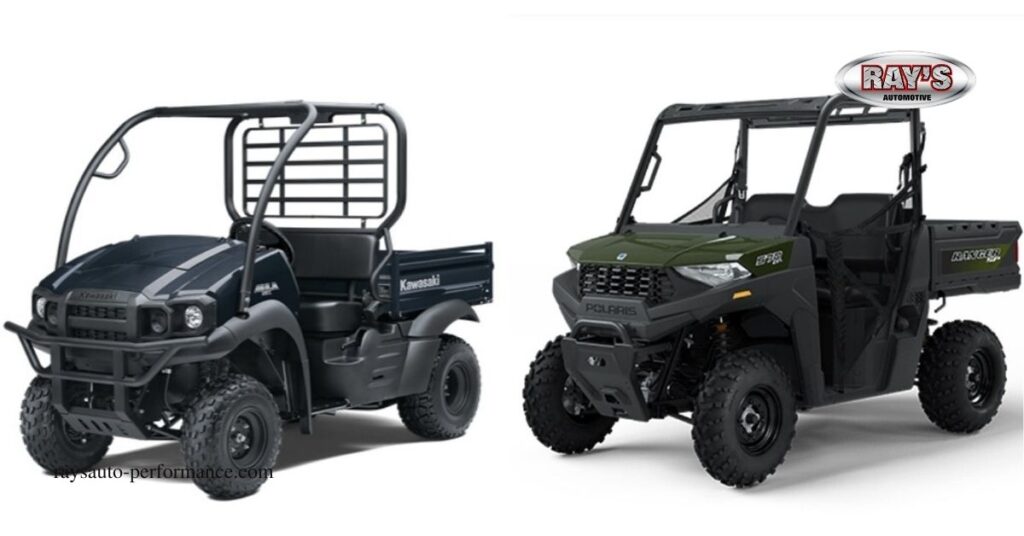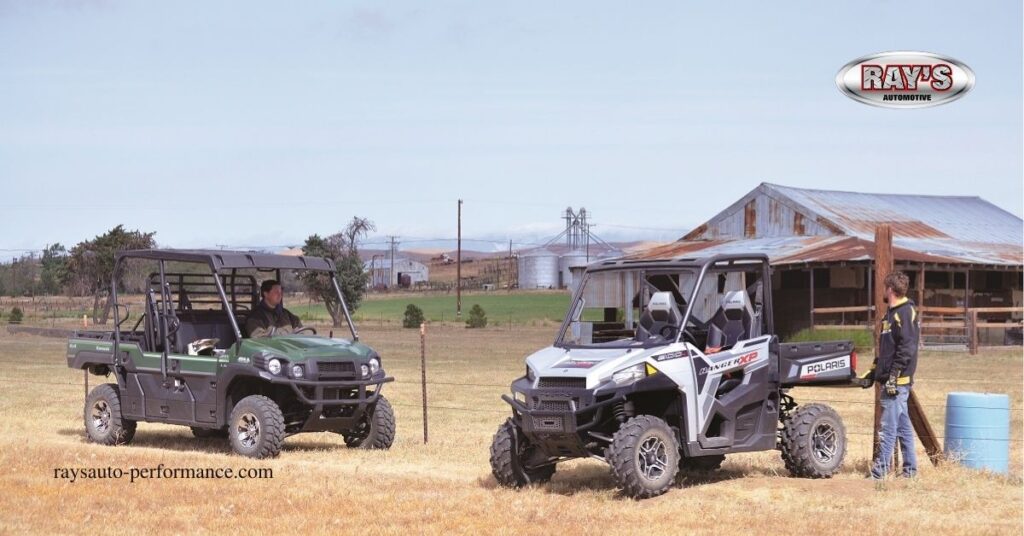When it comes to tackling tough terrain and getting the job done, choosing the right utility vehicle can make all the difference. You might find yourself torn between two heavyweights in the industry: the Polaris Ranger and the Kawasaki Mule. Both offer impressive features and capabilities, but which one truly fits your needs?
Overview of Polaris Ranger and Kawasaki Mule

Polaris Ranger and Kawasaki Mule stand out as top choices in the utility vehicle market. Each offers a unique blend of features suitable for various terrains and user needs.
Key Features Comparison
Polaris Ranger showcases impressive payload capacity. It typically carries up to 1,000 pounds, making it ideal for heavy-duty work. The vehicle also provides a powerful engine, often ranging from 570cc to 1,000cc, ensuring robust performance. Versatile seating options accommodate up to six passengers, improving its utility for group tasks.
Kawasaki Mule emphasizes durability and reliability. Its maximum payload capacity reaches approximately 1,200 pounds, slightly outperforming the Ranger in hauling capability. The Mule features a quieter operation due to its refined engine design, along with exceptional fuel efficiency, which benefits long work hours. Standard four-wheel drive enhances traction in rough conditions.
Target Audience and Use Cases
Polaris Ranger appeals to outdoor enthusiasts and agriculture professionals seeking a mix of power and performance. Many users use it for farming, hunting, or recreational activities, valuing its versatility. This vehicle’s off-road capabilities excel in rugged environments.
Kawasaki Mule targets users looking for durability and comfort. Landscapers, snow removal companies, and facilities maintenance crews frequently employ it. This model excels in providing a smooth ride on varied terrain, making it suitable for extended work sessions.
Performance and Power

Performance and power significantly influence your choice between the Polaris Ranger and the Kawasaki Mule. Each vehicle excels in its own way, catering to distinct needs and preferences.
Engine Specifications
The Polaris Ranger offers robust engine options, with the Ranger 1000 boasting a 992cc engine that produces 82 HP. This setup allows for faster acceleration and a higher top speed, making it an excellent choice for recreational activities and demanding tasks. An entry-level option, the Ranger SP 570, features a 567cc engine, providing up to 1,500 pounds of towing capacity along with a 500-pound bed capacity, making it versatile for various jobs.
In comparison, the Kawasaki Mule includes different engine sizes. The Mule 4010 4×4 FE comes with a 617cc, 4-stroke, 2-cylinder, OHV engine that generates 34.7 lb-ft of torque at 2,500 rpm. This focus on low-end torque makes the Mule ideal for heavy-duty applications, such as hauling and plowing.
Handling and Suspension
Handling and suspension contribute to comfort and performance in both models. The Polaris Ranger typically features an independent suspension system that enhances stability over uneven terrain. Its design ensures a smoother ride, aiding in maneuverability during off-road excursions.
Conversely, the Kawasaki Mule prioritizes durability with its rugged build. Many models come equipped with dependable suspension systems designed to absorb impacts. This focus on a comfortable ride enables you to navigate challenging surfaces with ease, making it suitable for long work hours and demanding conditions.
Comfort and Interior

Both the Polaris Ranger and Kawasaki Mule emphasize comfort and functionality, catering to your needs on challenging terrain.
Seating and Ergonomics
The seating arrangements differ between the two models. Polaris Ranger accommodates up to three passengers, offering adjustable seats that deliver exceptional support during long rides. Comfort stands out with its modern digital interface, presenting essential vehicle information clearly. Kawasaki Mule, on the other hand, provides seating for up to four passengers, making it suitable for transporting work crews or family members. Ergonomic designs in both vehicles enhance overall comfort, ensuring you can tackle demanding tasks or enjoy recreation without strain.
Storage Options
Storage options play a important role in utility vehicles. Polaris Ranger features multiple storage compartments that keep tools and personal items within easy reach, making organization convenient during outings. It also has a generous cargo bed that enhances hauling capabilities for any work-related or recreational needs. Kawasaki Mule includes integrated storage areas, providing ample space for equipment and supplies. Practicality remains a priority, with both vehicles designed to meet your storage requirements effectively.
Price and Value
When it comes to price and value, understanding the differences between the Polaris Ranger and the Kawasaki Mule helps you make an well-informed choice.
Cost Comparison
Starting with base models, the Kawasaki Mule SX offers a competitive price at $8,299. This entry-level model presents an attractive option for those on a budget. On the other hand, the Polaris Ranger SP 570 starts at $11,499, making it pricier at the entry level. High-end models also show similar pricing. For instance, the Kawasaki Mule Pro-FX retails for around $14,999, while the Polaris Ranger 1000 is slightly lower at $14,799. That slight difference in price between these high-end models doesn’t significantly impact the overall value you receive.
Warranty and Maintenance
Both brands provide competitive warranties, which adds to their value in the long run. While specifics can vary by model, Kawasaki offers a strong warranty that enhances your peace of mind during ownership. Polaris typically provides similar coverage, ensuring you can rely on their support for any issues that arise. Maintenance costs also play a crucial role. Routine maintenance for both vehicles should remain manageable, but understanding service requirements can save you money over time. By comparing these aspects carefully, you can choose a vehicle that aligns with your budget and long-term expectations.
User Reviews and Feedback

User reviews highlight crucial aspects of both the Polaris Ranger and Kawasaki Mule. Each model has distinct strengths that cater to different preferences.
Owner Experiences
Owners of the Polaris Ranger frequently comment on its versatility. Many appreciate the vehicle’s ability to handle both work tasks and recreational use effectively. Comfort stands out, with users reporting satisfied feelings about the seating and advanced features. The abundance of storage options also garners positive feedback, with features like GPS navigation improving the experience. The 4WD system receives high marks for traction, proving helpful in diverse terrains. But, some do mention that the CVT transmission could engage more smoothly, especially when reversing.
In contrast, Kawasaki Mule users emphasize reliability as a major benefit. You’ll notice that the Mule’s design prioritizes durability, making it ideal for long hours in the field. Owners regularly speak highly of the quiet operation, which adds convenience during use. Comfort is another area where the Mule shines, as owners report favorable experiences due to the ergonomic layout. The ease of navigation over challenging surfaces also contributes to satisfied user experiences.
Common Pros and Cons
Pros of the Polaris Ranger include versatile usage, comfortable seating, and advanced technology features. Owners frequently mention the ample storage space available in the Ranger. Customization options, like winches and plow attachments, add further appeal. The ability of its 4WD system to tackle various terrains makes a strong impression on users.
On the other hand, the Kawasaki Mule boasts higher payload capacity, quiet operation, and fuel efficiency. A important advantage is the spacious seating for up to four passengers, attracting families and teams alike. Owners often appreciate the rugged design, which stands up to demanding work environments.
Cons for the Ranger include occasional concerns about the CVT transmission, which some find less responsive. The price may also be a factor for budget-conscious buyers, as it typically has a higher starting point. About the Mule, users sometimes note that it lacks the same level of advanced features and power options found in the Ranger. This sometimes results in a less exhilarating driving experience.
By weighing these experiences and insights, you’ll find valuable information to help make an well-informed choice between the Polaris Ranger and Kawasaki Mule.
Conclusion
Choosing between the Polaris Ranger and Kawasaki Mule eventually depends on your exact needs and preferences. If you prioritize power and versatility for outdoor adventures or heavy-duty tasks, the Polaris Ranger may be your best bet. Its robust engine options and generous payload capacity make it a standout choice for those who need performance.
On the other hand, if durability and fuel efficiency are more important to you, the Kawasaki Mule offers exceptional reliability and comfort for long work hours. Its impressive payload capacity and smooth ride make it ideal for various applications.
Consider how you plan to use your utility vehicle and weigh the strengths of each model. By doing so, you’ll find the right fit that enhances your outdoor or work experience.
Frequently Asked Questions
What are the key features of the Polaris Ranger?
The Polaris Ranger features a powerful engine range from 570cc to 1,000cc, a maximum payload capacity of up to 1,000 pounds, and versatile seating for three passengers. It’s designed for heavy-duty work and outdoor activities, offering impressive acceleration and speed.
How does the Kawasaki Mule compare to the Polaris Ranger?
The Kawasaki Mule stands out with a higher payload capacity of about 1,200 pounds, quieter operation, and exceptional fuel efficiency. It can accommodate up to four passengers and is built for durability and comfort, making it ideal for long work hours.
Which vehicle is better for outdoor enthusiasts, the Ranger or the Mule?
The Polaris Ranger is generally better suited for outdoor enthusiasts due to its powerful engine options and acceleration. It is designed for demanding tasks and recreational activities, making it a favorite among those who seek a balance of power and performance.
What types of tasks are best suited for the Kawasaki Mule?
The Kawasaki Mule excels in tasks that require durability and long hours of operation, such as landscaping, snow removal, and facilities maintenance. Its quieter operation and comfort make it ideal for heavy-duty applications like hauling and plowing.
How do the handling and suspension differ between the two models?
The Polaris Ranger features an independent suspension system for a smoother ride over uneven terrain, enhancing stability. In contrast, the Kawasaki Mule focuses on durability with a rugged build and dependable suspension systems designed for absorbing impacts.
What interior features should I expect in the Polaris Ranger and Kawasaki Mule?
The Polaris Ranger offers adjustable seating and a modern digital interface, while the Kawasaki Mule emphasizes ergonomic designs for passenger comfort. Both vehicles have practical storage solutions, including multiple compartments in the Ranger and integrated storage in the Mule.
What are the price ranges for these vehicles?
The base model of the Kawasaki Mule SX is priced at $8,299, while the Polaris Ranger SP 570 starts at $11,499. Higher-end models have similar pricing, with the Mule Pro-FX around $14,999 and the Ranger 1000 slightly less at $14,799.
How do warranties compare for these utility vehicles?
Both Polaris and Kawasaki offer competitive warranties and manageable routine maintenance costs. These factors can significantly impact long-term ownership satisfaction, making it essential to consider warranty coverage when choosing a vehicle.
What do users typically say about the Polaris Ranger?
Owners of the Polaris Ranger frequently praise its versatility, comfort, and advanced features. Many appreciate the ample storage options and overall performance, though some express concerns about the CVT transmission and its higher price point.
What feedback do users provide about the Kawasaki Mule?
Kawasaki Mule users emphasize its reliability, quiet operation, and ergonomic design. They appreciate the higher payload capacity and fuel efficiency but note the lack of advanced features compared to the Polaris Ranger.

